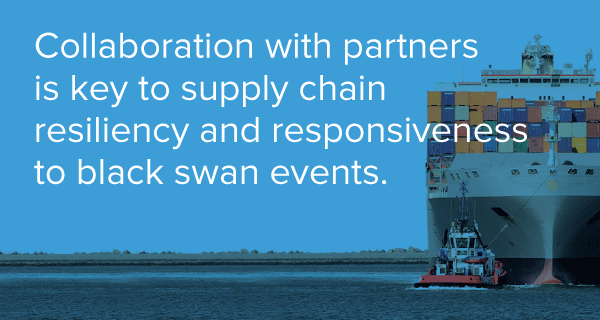by Buck Chintamani, GT Nexus
In a previous post, we looked at two key steps organisations need to take to mitigate the impact of black swan events in the supply chain. In this article, we discuss two further measures which help develop supply chain resilience and response capabilities.
Develop awareness and resiliency by collaborating
It is an oft-cited statistic that corporations that are not vertically integrated typically have over 80% of their supply chain data outside the enterprise. This usually emphasizes the need for connectivity with other supply chain partners so that decisions can be made based on 100% of the data, not just 20 percent.
There is another critical aspect to supply chain resiliency, and the responsiveness to black swan events—the need for effective collaboration with supply chain partners. Collaboration requires three key elements: connectivity, co-dependence, and trust.
Trust is the toughest thing to achieve today, with supply chains functioning as a key competitive advantage for companies. The best customers and the best suppliers are highly sought after, so establishing a relationship of trust, mutual respect, and regard for the others’ success is critical.
Early sharing of forecasts and orders is a good practice in itself. When facing a black swan event, the ability and willingness to communicate changes and insights early goes a long way to ensuring loyalty, trust, and continued shared success.
Today, this is further emphasized because different supply chains have critical capabilities concentrated in small geographies or markets. For example, the global toy industry is totally dependent on the manufacturing base located in Thailand – any geo-political disturbance in that far-off Asian country can cause complicated ramifications for toy-makers all over the world. In this sort of a situation, it’s even more important to establish collaborative relationships during the good times so that when problems arise, supply chain partners trust each other to provide early visibility.
Institutional Learning from Incursions
The best enterprises make every incursion and challenge a learning experience. The best companies learn to analyze each mistake and flaw, from quality incursions to missed deliveries, to isolate root causes and eliminate them. This discipline ensures that when a bigger incursion such as a black swan event occurs, the company is ready and able to isolate its impact and develop a contingency plan early.
This is similar to how the best sports teams function – they practice potential mistakes and how to recover from them. The best pianists are trained to pick up at different points in the composition and play the piece flawlessly from there. In the same manner, effective supply chains learn to orchestrate the flow of goods, and recover smoothly from disruptions, minor or major.
Supply chain management is hard work even during the best of times. Navigating through black swan events adds an additional layer of complexity and challenge.
The best supply chain managers, and corporations, are ready and able to take on this uncertainty through discipline, hard work, and intense preparation. These steps are a blueprint to achieve just that.













